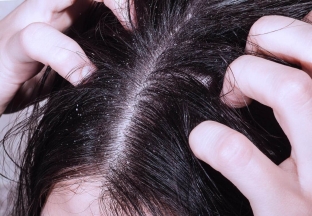Often we don't notice health problems until they start showing up in our appearance. So we try to eliminate dull hair, the presence of dandruff and their loss on our own, without resorting to the advice of doctors. But in vain! After all, all these symptoms can be the cause of more complex diseases that only a specialist can cure. Today we will talk about the fungus of the scalp, which has all of the above symptoms. His treatment takes a long time, so be attentive to the symptoms and do not miss the moment.
What are the symptoms of scalp fungus?
Skin manifestations on the scalp with fungal diseases depend on the type of fungal bacteria. But to summarize, they are like this:
- The state of the hair itself changes, its structure: it becomes dull, weak, dry, brittle;
- Scaly areas appear, and they are outlined in a round shape;
- Hair loss is very noticeable, especially in areas with peeling. There is partial baldness in this area;
- Pink plaques appear on the surface of the scalp, they can become blistered and have yellow and gray crusts;
- The hair breaks at the very base;
- Purulent manifestations at the site of the lesion are noticeable.

Most often, the scalp is affected by fungal infections of the type: Microsporum (microsporia) and Trichophyton (trichophytosis).
Microsporia is usually characterized by one or more infected areas with a small amount of hair of indeterminate color in the middle. Some broken hair may remain.
Trichophytosis is caused by the presence of black dots in the infected area. Hair is also preserved on it, but they are quite short up to 3 mm. The affected area may be outlined in black.
It usually takes a long time after infection for the first symptoms to appear. If you have a large amount of dandruff that was previously unusual for you, this is the first sign that you need to see a doctor. The sooner treatment begins, the less problems there will be later.
Bacteria, viruses and fungal infections are the cause of such diseases.
How do trichophytosis and microsporia differ from each other?
Trichophytosis has long been called ringworm by the people, confirms estet-portal.com. It has superficial and deep forms. The disease is quite contagious and is transmitted by personal contact or by contact with the things of the patient. Most often, children suffer from it. The disease can also be transmitted from animals. Bald spots, itching, swelling are observed on infected areas. Hair breaks up to 2 mm and is covered with a gray coating. Symptoms may appear as early as five to seven days after infection. Such manifestations are usually observed in the superficial form.
The most insidious – this is a deep form, the incubation period of which is 2 months. Up to this point, she does not show herself at all. It may be accompanied by fever and general malaise. It spreads very quickly throughout the body. It can affect not only the head, but also other parts of the skin, as well as nails, eyebrows and eyelashes. There is an increase in lymph nodes. Ulcers form on the head in the infected areas, which become very painful.
Microsporium spreads most quickly over the surface of the skin. It also most often infects children. Its symptoms are similar to superficial trichophytosis, therefore, in order to accurately establish the type of disease, it is necessary to do a laboratory analysis. However, with microsporia there are no obvious inflammatory processes.
Treatment and diagnosis of scalp fungus
Diagnosis begins with a visual inspection. Then take on the study of hair and flaky pieces of skin. With the help of a Wood's lamp, the presence of a fungus is detected, then its appearance is established. And only then a bacteriological culture is prescribed.
As a rule, the hair around the infected area is shaved off. If there are many lesions, then the scalp is completely removed.
Systemic antifungal drugs are usually used for treatment. They are quite effective, but have strong toxicity, therefore they have contraindications for: oncology, kidney failure, blood diseases, etc. In special cases, antibiotics and hormonal agents may be added to the treatment. They can also connect immunostimulants and drugs to improve blood circulation. The treatment lasts more than one month and depends on the degree of the patient's lesion.
Timely contacting a specialist will save you from long-term treatment, be attentive to symptoms from estet-portal.com.






Add a comment